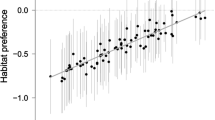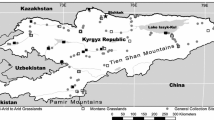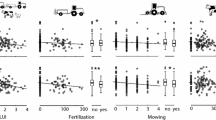Summary
Rhinanthus minor (yellow-rattle) is a widespread hemiparasitic plant of grassland habitats throughout Great Britain. It is usually considered to be indicative of species-rich grassland, but in a survey of 14 habitats throughout Britain it was found that R. minor at the time of flowering normally occupied relatively low-diversity patches within areas of high diversity as determined by the number of species, Simpson's Index and the Shannon-Wiener Index. Following the death of adult plants of R. minor in the summer it was shown that the pattern of species diversity changed such that by the time R. minor germinated in the following spring the differences between the areas containing and not containing R. minor were much less distinct. A perturbation experiment in which R. minor was removed from four sites indicated that the effect of the removal of R. minor on the development of community structure over the next year was to increase species diversity on three of the sites and decrease it on the fourth. Those species which responded to the removal of R. minor by an increase in abundance were shown to be preferred hosts. All three lines of evidence point to the fact R. minor has a significant effect on the species diversity of the communities in which it grows by selectively parasitizing components of the flora and modifying the competitive relationships between plants. However, as the communities generally responded to the removal of R. minor by an increase in diversity and as the general survey indicated that R. minor is generally associated with areas of low diversity it would appear that the plants which are selectively parasitized are generally not the competitive dominants in the community.
Similar content being viewed by others
References
Allred KR (1966) Translocation of radioactive substances in the Medicago-Cuscuta complex after exposure to C14O2. Adv Front Plant Sci 16: 1–9
Anderson RM, May RM (1986) The invasion, persistence and spread of infectious diseases within animal and plant communities. Phil Trans R Soc Lond 314: 533–570
Atsatt PR (1983) Host-parasite interactions in higher plants. In: Lange OL, Nobel PS, Osmond CB, Ziegler H (eds) Encyclopedia of Plant Physiology. 12c Physiological Plant Ecology III. Responses to Chemical and Physical Environment. Springer, Berlin, pp 519–535
Borg SJ ter (1985) Population biology and habitat relations of some hemiparasitic Scrophulariaceae. In: White J (ed) The Population Structure of Vegetation. Junk, Dordrecht, pp 463–487
Borg SJ ter, Bastiaans JC (1973) Host parasite relations in Rhinanthus serotinus. I. The effect of growth conditions and host; a preliminary review. In: Proceedings of the European Weed Research Council Symposium on parasitic weeds. Malta University Press, pp 236–246
Burdon JJ, Chilvers GA (1977) The effect of barley mildew on barley and wheat competition in mixtures. Aust J Bot 25: 59–65
Burdon JJ, Groves RH, Kaye PE, Speer SS (1984) Competition in mixtures of susceptible and resistant genotypes of Chondrilla juncea differentially infected with rust. Oecologia 64: 199–203
Clapham AR, Tutin TG, Moore DM (1987) Flora of the British Isles, 3rd edn. Cambridge University Press, Cambridge
Crawley MJ (1983) Herbivory: The Dynamics of Animal-Plant Interactions. Blackwell Scientific Publications, Oxford
Daams J (1975) Parasitic plants as weeds. Acta Bot Neerl 24: 243–244
Day FP, Monk CD (1974) Vegetation patterns on a southern Appalachian watershed. Ecology 55: 1064–1074
Gates DJ, Westcott M, Burdon JJ, Alexander HM (1986) Competition and stability in plant mixtures in the presence of disease. Oecologia 68: 559–566
Gibson CC (1986) The population and community biology of Rhinanthus minor L. PhD thesis, University of East Anglia
Gibson CC, Watkinson AR (1989) The host range and selectivity of a parasitic plant: Rhinanthus minor L. Oecologia 78: 401–406
Gibson CC, Watkinson AR (1991) Host selectivity and the mediation of competition by the root hemiparasite Rhinanthus minor. Oecologia 86: 81–87
Govier RN, Harper JL (1964) Hemiparasitic weeds. Proc 7th Br Weed Control Conf 7: 577–582
Govier RN, Nelson MD, Pate JS (1967) Hemiparasitic nutrition in angiosperms I. The transfer of organic compounds from host to Odontites verna (Bell.) Dum. (Scrophulariaceae). New Phytol 66: 285–297
Harper JL (1977) Population Biology of Plants. Academic Press, London
Hassawy GS (1973) Cuscuta species in Iraq; their hosts and germination. Proceedings of the European Weed Research Council Symposium on Parasitic Weeds. Malta University Press, pp 280–288
Hassell MP, Anderson RM (1989) Predator-prey and host-pathogen interactions. In: Cherrett JM (ed) Ecological concepts. Blackwell Scientific Publications, Oxford, pp 147–196
Kuijt J (1969) The Biology of Parasitic Flowering Plants. University of California Press, Berkeley
Leonard OA, Hull RJ (1965) Translocation relationships in and between mistletoe and their hosts. Hilgardia 37: 115–153
Mizianty M (1975) Influence of Rhinanthus serotinus (Schönh.) Oborny on the productivity and floristic composition of the meadow plant association. Fragm Florist Geobot (Krakow) 21: 491–505
Musselman LJ, Mann WF (1977) Host plants of some Rhinanthoideae (Scrophulariaceae) of eastern North America. Plant Syst Evol 127: 45–53
Newhook FJ, Podger FD (1972) The role of Phytopthora cinnamomi in Australian and New Zealand forests. Ann Rev Phytopathol 19: 299–326
Park T (1948) Experimental studies of interspecific competition. 1. Competition between populations of the flour beetles, Tribolium confusum Duval. and Tribolium castaneum Herbst. Ecol Monogr 18: 267–307
Parker C (1986) Scope of the agronomic problems caused by Orobanche species. In: ter Borg SJ (ed) Proceedings of a workshop on biology and control of Orobanche. LH/VPO, Wageningen, The Netherlands, pp 11–17
Paul ND, Ayres PG (1986) Interference between healthy and rusted groundsel (Senecio vulgaris L.) within mixed populations of different densities and proportions. New Phytol 104: 257–269
Piehl MA (1963) Mode of attachment, haustorium structure and hosts of Pedicularis canadensis. Am J Bot 50: 978–985
Press MC, Shah N, Touhy JM, Stewart GR (1987) Carbon isotope ratios demonstrate carbon flux from C4 host to C3 parasite. Plant Physiol 85: 1143–1145
Rabotnov TA (1959) The effect of Rhinanthus major Ehrh. upon the crops and the composition of the flood land herbage. Byull Moskva Ispyt Prir 64: 105–107
Rao PN, Reddy A (1987) Effect of china dodder on two pulses: Green gram and cluster bean — the latter is a possible crop trap to manage china dodder In: Weber HC, Forstreuter W (eds) Parasitic Flowering Plants. Marburg, F.R.G., pp 665–674
Roame MK, Griffin GJ, Rush JR (1986) Chestnut blight, other Endothia diseases, and the genus Endothia. American Phytopathology Society, St Paul, Minnesota
Saadi Gharib M (1973) Biological and economic aspects of the broomrapes (Orobanche spp.) in Northern Iraq. Proceedings of the European Weed Research Council Symposium on Parasitic Weeds. Malta University Press, pp 44–47
Salageanu N, Fabian-Galan G (1968) Studies on the nutrition of Cuscuta sp. Rev Roum Biol Bot 13: 321–324
Sarpe N, Halalau D, Guta M (1973) Research on the chemical control of dodder in lucerne and red clover. Proceedings of the European Weed Research Council Symposium on Parasitic Weeds. Malta University Press, pp 289–295
Schmitt U (1979) Distribution and importance of Orobanche crenata on broad beans in Morocco. In: Musselman LJ, Worsham AD, Eplee RE (eds) Proceedings of the Second Symposium on Parasitic Weeds. North Carolina State University, Raleigh, pp 103–108
Smith AJE (1963) Variation in Melampyrum pratense. Watsonia 5: 336–367
Smith D, Muscatine L, Lewis D (1969) Carbohydrate movement from autotrophs to heterotrophs in parasitic and mutualistic symbiosis. Biol Rev 44: 17–90
Tansley AG (1965) The British Isles and Their Vegetation, 4th edn. Cambridge University Press, Cambridge
Weber HC (1976) Über Wirtspflanzen und Parasitismus einiger mitteleuropäischer Rhinanthoideae (Scrophulariaceae). Plant Syst Evol 125: 97–107
Weste (1981) Changes in the vegetation of sclerophyll shrubby woodland associated with invasion by Phytopthora cinnamomi. Aust J Bot 29: 261–276
Author information
Authors and Affiliations
Rights and permissions
About this article
Cite this article
Gibson, C.C., Watkinson, A.R. The role of the hemiparasitic annual Rhinanthus minor in determining grassland community structure. Oecologia 89, 62–68 (1992). https://doi.org/10.1007/BF00319016
Received:
Accepted:
Issue Date:
DOI: https://doi.org/10.1007/BF00319016




